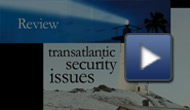NATO Review topical page about:
terrorism

Germany has suffered from right wing, left wing and religious homegrown terrorist attacks and activities. Here, Rolf Tophoven outlines what can be learned from the country's experiences.

Will the present economic downturn - with its higher rates of youth unemployment, depression and disillusionment - have any impact on homegrown terrorist recruitment or activity? Dr Brooke Roger looks at how much we can know.

Seek and you shall find is an old phrase. But it is an apt one, argues Benjamin Friedman, when applied to the search for something which has almost certainly always been there.

The tag ‘homegrown terrorism’ may be new. But the activity certainly isn’t. This photostory highlights some previous examples – stretching back almost a century.

Homegrown terrorism is not new, argues Marc Sageman. It is as old as political struggle. But it does have new elements in it – not least being the Internet.

The threat from homegrown terrorists is clearly a security issue. But it is one largely dealt with by national intelligence and security forces – not the military. So what exactly can NATO do to counter it? And how does this fit into NATO's wider fight against terrorism? We ask NATO’s counter terrorism expert.

Stanislava Mladenova has spent half her life in Europe, half in the US. Here she describes the role NATO has played in bringing the strands together.

This 10 question quiz will find out how well you know the Alliance.

Dr. Sima Samar was the Minister of Women's Affairs of Afghanistan from 2002 to 2003. The fact that the job even existed showed the difference in Afghanistan from Taliban rule. But how successful have other initiatives been during the last 10 years?

Nelofer Pazira has seen the many faces of Afghanistan. And while there has been progress, she feels that the country is yet to escape its cycle of suffering. Here she charts her experiences and impressions, from living there in the turbulent 1980s to visiting today’s Afghanistan.

Can we compare an Afghanistan of beheadings and torture to today’s? Mr. Shafiq Hamdam looks at the Afghanistan he has seen. He concedes it’s not yet perfect. But concludes that it’s come a long way.

Imagine being an Afghan-American in September and October 2001. Both your countries were attacked. One by the other. How did Afghan-Americans react? Where were their allegiances? And what could they do to help both countries? We asked an Afghan-American how he dealt with this dilemma.

In 2008, NATO Review asked award-winning Afghan blogger Nasim Fekrat to illustrate how he saw his country. This month, as the country marks the 10th anniversary of the start of operations to oust the Taliban, we ask him what the biggest changes have been in the Afghanistan he knows.

Afghanistan is a photojournalist's paradise. The light and colours make for great photos. The people make for engaging subjects. And the country's stories make for a gripping tale. Here, we publish some of the most striking images.

9/11 heralded an age of new threats. Not least of these is the cyber threat. Here, Olaf Theiler outlines how NATO has had to adapt quickly to a fast changing, pervasive and often cheap security threat.

In retrospect, instead of heralding NATO's decline, "09/11" became the catalyst for the most fundamental changes in NATO's history, argues Michael Ruhle. Yet for the NATO Allies, the questions they had to ponder from the outset were as obvious as they were profound.

The ten years since the 9/11 attacks have thrown up new and challenging security risks. How well have we kept up with them? Has NATO changed enough? In this edition, we look at what the security world has learnt since that historic day.

Gillian Goh and Christopher Clark of the UN explain how new guidelines could help put small arms and ammunitions further from the reach of terror groups

Gretchen Peters spent over a decade as a news reporter covering Pakistan and Afghanistan. Here she argues that the main way to fight the Taliban and al Qaeda there is through cutting off their drugs money.

NATO Review talks to Marisa Porges, former counter-terrorism advisor to the US Government, about the threats posed by, to and in Yemen.

Want a quick guide to the problems in Yemen? Here's a three minute video which gives the key facts about Yemen, why it matters, the issues at stake and how it may affect us all.

How does al Qaida growth's in Yemen look to Yemeni eyes? Faris Sanabani explains the particular national characteristics that he thinks have played a role in making Yemen the home to al Qaida in the Arabian Peninsula.

Al Qaida in the Arabian Peninsula is a moving target, literally. When attacked by Western forces after the attempted Christmas day bombing last year, it changed its strategy.

Could Yemen's multiple challenges spill over into neighbouring countries? How well prepared are these countries ? David Hughes looks at the threat of a regional domino effect.

Since its birth in 2009, al Qaida in the Arabian Peninsula (AQAP) has thrived in Yemen because the country has so many other problems, argues Chris Boucek.

Football's links with war and peace go back almost to the founding of the game. This selection of photos show some of the key moments when security and the game overlapped.

NATO Review spends a day with Operation Active Endeavour to see how it keeps a close eye on the Mediterranean Sea - and how it's used.

Whether it's civil wars, ethnic conflicts or simply occupations, football has helped highlight differences, overcome them or been used in protest. Here are a few examples.

Is the biggest nuclear threat actually not nuclear weapons but rather a terrorist dirty bomb - the explosion of nuclear materials? Many think so. Here we outline what the dangers are and how the consequences would affect us.

What role do nuclear issues have in NATO? How does the Alliance see the changes in the nuclear political landscape this year and how will this be reflected in its new Strategic Concept?

There has not been a single incident of terrorist arrests in the Mediterranean since the beginning of counter-terrorist operations started there in 2001. Here, a member of the operation explains how the sea is kept safe.

Is it really the end of the naval era? Could there be more lawless areas of sea in the future? And how will climate change affect the maritime situation. Diego Ruiz Palmer looks into the issues.

Ports and the open sea play a key role as organised crime and terror groups need to move their goods around the world. This video investigates how.

NATO Review looks at how terrorist and organised crime groups work together and asks whether they are really different at all.

Even the US President has commented on Mexico's troubling drug wars. But here Sam Quinones, who lived in Mexico for a decade, argues that the country’s problems have limited security implications for the US – for the moment.

A photostory outlines the trades that organised crime, and some terror groups, specialise in: from cigarettes to credit cards and from cybercrime to piracy.

Three minutes showing how the financial crisis could impact on security issues from migrant workers through to extremist political groups.

François Melese argues that the impact of the financial crisis on security cannot be underestimated. And he looks at whether it originated in the private or public sector.

Farah provincial Governor Roohul Amin outlines his thoughts on this year's elections, the effect of poppies now and what must happen to the Taliban.

We asked six people, with excellent insights into their respective areas, two simple questions about 2009: what and who would be key in the security arena. Here, we publish their answers.

Ahmed Rashid, author of the seminal book 'Taliban', talks to NATO Review about how terror, tribalism and the Taliban fit together.

What has been the influence of technology, foreigners recruits and counter insurgency efforts on the Taliban over the past five years? Paula Hanasz reviews a new Antonio Giustozzi book which homes in on these issues.

What difference would a clear, defined counter terrorism strategy make to NATO? Seda Gurkan looks into the pros and cons.

Terrorism attacks are often cheap. Efforts to stop them can be very expensive. Is there a way of guaranteeing that this money is well spent?

This month's photostory looks at how terrorism has changed over the years, and the major challenges it poses today.

Suicide bombings are bad enough. But suicide nuclear bombs would spell catastrophe. Michael Rühle looks at how jihadists’ attempts to join the nuclear club have been thwarted – and what’s needed to stave off this threat.

Friedrich Steinhäusler describes the asymmetric threats that face the transatlantic community and NATO's efforts to confront them.

Edgar Buckley describes how NATO invoked Article 5 on 12 September 2001, 24 hours after the terrorist attacks against the United States.

Tomas Valasek examines evolving attitudes to collective defence at NATO from the perspective of the countries of Central and Eastern Europe.

Stanley R. Sloan analyses the debate over Article 5 that dominated the Washington Treaty negotiations.

Rafael L. Bardají versus Daniel Keohane

Hikmet Çetin is NATO’s Senior Civilian Representative in Afghanistan and as such is the political face of the Alliance on the ground. He was appointed in November 2003 and has been based in Kabul since January 2004.

Sebestyén L. v. Gorka analyses the significance of the invocation of Article 5 of the Washington Treaty five years on.

Mustafa Alani presents his analysis of Arab attitudes to NATO and how the Alliance may seek to overcome stereotypes and prejudices.

Sergei Ivanov analyses the evolution of NATO-Russia relations since the creation of the NATO-Russia Council.

Julian Lindley-French articulates seven strategic messages for the Euro-Atlantic community.

NATO is strengthening the Alliance’s missile defence capabilities in response to the growing threat posed by the proliferation of weapons of mass destruction and their delivery systems.

Peter van Ham examines the challenges NATO is facing as it takes on an increasingly global role.

Ever since passenger aircraft were flown deliberately into the twin towers of the World Trade Center in New York and the Pentagon in Washington DC on 11 September 2001, discussions of terrorism and ways to combat this menace have featured prominently on NATO’s agenda. Indeed, just one day after the 9/11 terrorist attacks, the Alliance invoked Article 5, its collective-defence clause, for the first time in its history.

Dagmar de Mora-Figueroa examines how NATO has responded to the terrorist threat since the 11 September terrorist attacks against the United States.


Gijs de Vries became the European Union’s first counter-terrorism coordinator in March 2004.

NATO’s Multinational Chemical, Biological, Radiological and Nuclear (CBRN) Defence Battalion is both an effective solution to a capabilities shortfall and a model for future NATO transformation.

The statistics represented graphically below come from the document NATO-Russia Compendium of Financial and Economic Data Relating to Defence that the NATO-Russia Council publishes once a year and can be found at www.nato.int/docu/pr/2005/p050609e.htm.

Andrei Kelin describes how NATO and Russia are forging an increasingly effective partnership to combat the terrorist threat.

Eric R. Terzuolo considers NATO’s role in combating the proliferation of weapons of mass destruction.

Vice Admiral Roberto Cesaretti examines how NATO has been combating terrorism in the Mediterranean since October 2001.

C. Richard Nelson analyses NATO's contribution to the fight against terrorism and suggests how it might be enhanced.

Marshall Billingslea examines how NATO is developing technology to counter increasingly sophisticated terrorism.

Christopher Bennett analyses how the Alliance has refined its contribution to the war on terrorism and compares the current debate on NATO reform with that of a decade earlier.

Osman Yavuzalp describes how NATO members and Partner countries will be working together to combat terrorism.

quotes
Benjamin Franklin (1706-1790),
Poor Richard's Almanac, 1746
When the well is dry,
we know the worth of water





















